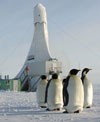 The last time CO2 hit a sustained level of 400 ppm 15-20 million years ago global average temperatures were 3 – 6ºC warmer than now, and sea level was 25 to 40 m higher, according to research released last week. That’s bad news, because the target for current international negotiations to find a successor to Kyoto is 450 ppm. The finding also provides support for James Hansen’s view that 350 ppm is the maximum “safe level” for CO2 if we want to inhabit a planet with ice at both poles.
The last time CO2 hit a sustained level of 400 ppm 15-20 million years ago global average temperatures were 3 – 6ºC warmer than now, and sea level was 25 to 40 m higher, according to research released last week. That’s bad news, because the target for current international negotiations to find a successor to Kyoto is 450 ppm. The finding also provides support for James Hansen’s view that 350 ppm is the maximum “safe level” for CO2 if we want to inhabit a planet with ice at both poles.
Meanwhile, analysis of the Andrill core has discovered a “remarkably warm” period in Antarctica that occurred abruptly 15.7 million years ago, when the McMurdo Sound region could have had January air temperatures of 10ºC and sea temps up to 11.5ºC, according to a new paper in Geology.
A new method of assessing CO2 levels from ocean drill cores has enabled scientists to build a CO2 record back 20 million years, covering major episodes of glaciation. Here’s the abstract from Coupling of CO2 and Ice Sheet Stability Over Major Climate Transitions of the Last 20 Million Years by Tripati et al, in Science Express this week:
The CO2 content of the atmosphere has varied cyclically between ~180 and ~280 ppmv over the last 800,000 years, closely coupled with temperature and sea level. For earlier periods in Earth’s history, pCO2 is much less certain and the relationship between pCO2 and climate remains poorly constrained. We use boron/calcium ratios in foraminifera to estimate pCO2 during major climate transitions of the last 20 million years (myr). During the Middle Miocene, when temperatures were ~3 to 6°C warmer and sea level 25 to 40 meters higher than present, pCO2 was similar to modern levels. Decreases in pCO2 were synchronous with major episodes of glacial expansion during the Middle Miocene (~14 to 10 million years ago; Ma) and Late Pliocene (~3.3 to -2.4 Ma).
Lead author Aradhna Tripati, an assistant professor at UCLA comments [Science Daily]:
“We have shown that [a] dramatic rise in sea level is associated with an increase in carbon dioxide levels of about 100 parts per million, a huge change,” Tripati said. “This record is the first evidence that carbon dioxide may be linked with environmental changes, such as changes in the terrestrial ecosystem, distribution of ice, sea level and monsoon intensity.”
The BBC report develops the obvious policy implications.
The news from Andrill is equally striking:
Among the 1,107 meters of sediments recovered and analyzed for microfossil content, a two-meter thick layer in the core displayed extremely rich fossil content. This is unusual because the Antarctic ice sheet was formed about 35 million years ago, and the frigid temperatures there impede the presence of woody plants and blooms of dinoflagellate algae.
“We all analyzed the new samples and saw a 2,000 fold increase in two species of fossil dinoflagellate cysts, a five-fold increase in freshwater algae and up to an 80-fold increase in terrestrial pollen,†said [lead author] Sophie Warny. “Together, these shifts in the microfossil assemblages represent a relatively short period of time during which Antarctica became abruptly much warmer.â€
It would be interesting to know if the new CO2 record shows any anomalies around 15.7 m years ag. At the very least, this discovery would suggest that Antarctica was warm enough to support trees, at least around the coast, when CO2 was in the region of 400 ppm. If you needed reminding, we’re currently at 387 and rising. The long term forecast just got a lot worse…
